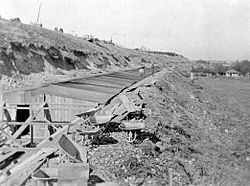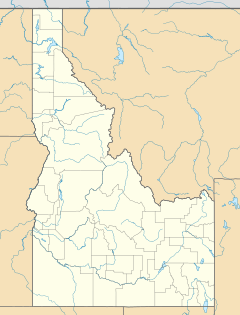New York Canal facts for kids
Quick facts for kids New York Canal |
|
|---|---|

The New York Canal in 1910
|
|
| Location | Ada County, Idaho Canyon County, Idaho |
| Country | USA |
| Coordinates | 43°34′27″N 116°14′21″W / 43.574076°N 116.239050°W |
| Specifications | |
| Length | 66 km (41 miles) |
| History | |
| Former names | Main Canal |
| Current owner | United States Bureau of Reclamation |
| Original owner | Idaho Mining and Irrigation Company |
| Principal engineer | Arthur De Wint Foote |
| Construction began | 1890 |
| Date completed | 1909 |
| Geography | |
| Direction | Southwest |
| Start point | Boise River Diversion Dam |
| End point | Lake Lowell |
| Beginning coordinates | 43°32′15″N 116°05′39″W / 43.537604°N 116.094060°W |
| Ending coordinates | 43°31′39″N 116°36′20″W / 43.527401°N 116.605659°W |
The New York Canal is a really important waterway in Idaho. It's a long, 41-mile (about 66 km) canal that helps bring water to farms. This canal starts at the Boise River Diversion Dam and flows all the way to Lake Lowell. Think of it as a giant water delivery system!
It has many smaller canals branching off it. These branches help spread water to about 165,000 acres of farmland. That's a huge area, almost like 125,000 football fields! The canal can carry a lot of water, about 2,400 cubic feet every second.
Contents
Building the New York Canal
Early Ideas for Water
In the early 1880s, a new railroad called the Oregon Short Line Railroad was finished. This made it easier for people to move to the Boise Valley and start farms. But the land was very dry, like a desert.
In 1882, some people from New York decided to help. They started a company called the Idaho Mining and Irrigation Company. Their big idea was to turn the desert into rich farmland. They also hoped to find valuable minerals in the area.
Arthur Foote's Big Plan
A smart engineer named Arthur De Wint Foote started exploring the Boise Valley in 1883. He imagined a huge canal, about 75 miles long. This canal would take water from the Boise River. It would then water half a million acres of dry land using 5,000 smaller ditches.
The main canal they planned became known as the New York Canal. This was a way to honor the investors from New York who were helping to pay for it.
Other Water Projects
The New York Canal wasn't the very first irrigation system in the Boise Valley. Before it, in 1878, a man named William H. Ridenbaugh started building the Ridenbaugh Canal. Smaller water projects had also been around since the 1860s.
Challenges and Slow Progress
Building the New York Canal was very difficult. Workers had to move huge rocks and cut through hard ground. This made the work go slowly.
Also, there was a tough time for the economy called the Depression of 1882–85. Some of the investors from New York lost money and had to stop helping the company. Arthur Foote kept working even when he didn't get paid much. The company did just enough work to keep their water rights.
Newspaper Doubts
In 1888, a local newspaper, the Idaho Statesman, didn't believe the canal would be finished soon. They said only "maps and profiles" were done. The newspaper thought it would take 500 workers five more years to finish the canal.
In 1889, the company's manager, Charles H. Tompkins Jr., said the canal would be 70 miles long. He thought it would water about 350,000 acres. But he admitted that only two miles were actually built. Another project, the Phyllis Canal, also had only two miles finished. The Phyllis Canal later became part of the New York Canal system.
More Money, More Workers
In 1890, the company got $300,000 to finish the canal. A builder named William C. Bradbury was hired. They hoped to finish the canal by 1891. By September 1890, 220 workers were on the job. The company even wanted to hire 1,000 more!
But the work continued into 1892. Then, it stopped because the investors had disagreements. Work finally started again in 1893.
New Owners Take Over
The Idaho Mining and Irrigation Company ran out of money in 1891. The builder, William C. Bradbury, took over the project. He kept building the canal, possibly using his own money.
In 1894, he bought the canal, the land, and the water rights at a special sale. Later, in 1896, he sold the unfinished canal to a group of about 175 local farmers. They formed a group called the Farmers' Canal Company.
The Government Steps In
In 1902, the United States government created the United States Bureau of Reclamation. This group took control of the New York Canal project. They made some changes to the design, making the canal a bit shorter.
Finally, after much hard work, the New York Canal officially opened on February 22, 1909. The canal was made even bigger by 1912. In 1926, it became part of a larger water project called the Boise Project.



